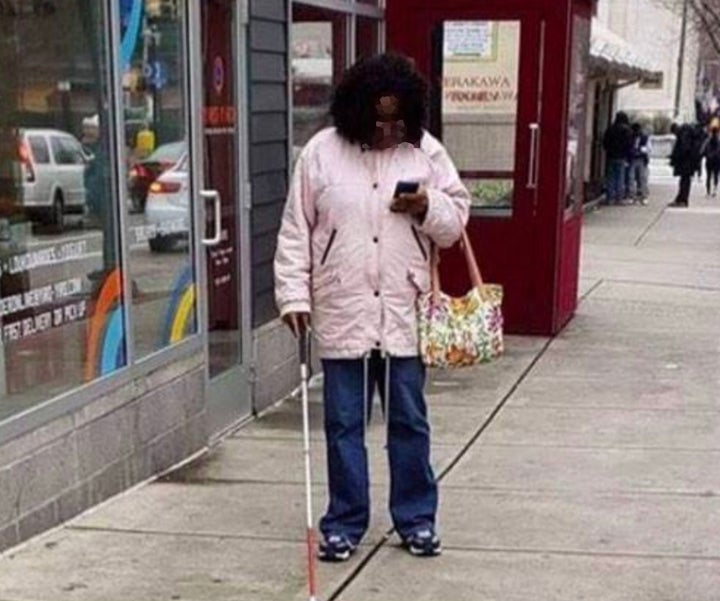
Earlier this month, the #BirdBoxChallenge had people across the world donning a blindfold and trying to carry out everyday activities. While I’m not sure that covering your eyes and putting yourself in potentially dangerous situations does much to improve your understanding of what it’d be like to be blind or partially sighted, it did trigger some interesting debate. After all, hearing people talking about not being able to see is the first step towards raising awareness of what it really means.
With the #BirdBoxChallenge just dying down, I’d hoped that people’s willingness to engage positively with the idea of sight loss would be at an all-time high. But when I read about a Facebook image that went viral for all the wrong reasons, my hopes were dashed.
The photo shows a woman walking down the street while looking at her phone. Nothing remarkable about it really, except she is using a cane – she is partially sighted. And the reason this image has been shared and liked thousands of times on social media? People are suggesting that, because she is looking at her phone, she is faking being blind.
This just goes to show how far there is to go in improving the general public’s understanding of how blind and partially sighted people go about everyday activities. Sadly, at RNIB, we hear of stories like this all too often – where people going about their daily lives are told that they ‘don’t look blind’ and face prejudice and discrimination in all sorts of ways.
Research commissioned by RNIB last year revealed that the biggest barrier that blind and partially sighted people face is other people’s limited knowledge and understanding of sight loss. A general lack of awareness, incorrect assumptions and outdated stereotypes were judged to be a bigger barrier to inclusion than practical challenges, like navigating streets and using public transport.
These findings were backed up by a poll of the general public, which showed that more than a quarter of those surveyed wrongly assumed that blind and partially sighted people cannot read books and almost a third said that we cannot enjoy TV and films.
Like everyone, blind and partially sighted people use phones, read books and watch TV. And they do so in lots of different ways; perhaps by making the most of the vision they do have, having things read out by a synthetic voice or reading braille on a digital display.
At RNIB, we passionately believe that blind and partially sighted people should be able to lead the lives we want to lead, without barriers and without being told what we can or can’t do. Particularly when those opinions are based on outdated stereotypes and prejudices that do not belong in the 21 Century.
Social media posts like this do real harm. Ill-informed stories and ignorant reactions can dent people’s self-confidence and increase the sense of isolation that, sadly, many blind and partially sighted people feel. They also contribute to creating a society that judges people based on the disability they happen to have, not the person they choose to be. In a world in which social media is so influential, where people can broadcast anonymous judgement to the world with the click of a button, we urge everyone to think before they offer their opinion.
Breaking down the barriers that still exist – whether that’s about changing perceptions or removing physical obstacles – relies on blind and partially sighted people having the confidence, practical and emotional support and opportunities to thrive. It’s also about feeling connected to other people, locally or through shared interests, and improving society’s understanding of the spectrum of sight loss and what it really means. We clearly have a long way to go.
Ellie Southwood is chair of the Royal National Institute of Blind People